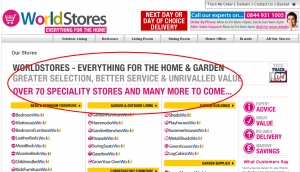Part 2 – Hands Up I Was Wrong – But What About?
In this second part of the History of Multi-Channel Software, we’re starting a journey, a journey to find the utopia and a journey that we’re going to share openly, wins, failures, the lot.
The utopia for multi-channel software that can fit the needs of any business regardless of size, type, location or revenue both today and tomorrow.
And to do this effectively, I need to admit I was wrong.
A Re-Cap
In part 1 of the History of Multi-Channel Software we covered how we have ended up where we are today with the collection of software providers that offer pretty much the same options, all wrapped up into different interfaces for multi-channel businesses to use.
I also shared with you the vision for the future which I’ve put below, the “utopia”, the goal that we’re aiming for and the commitment that I believe together we can achieve. I also admitted that I don’t have all the answers and never will but are willing to share this journey as we go and we invited you to join in.
The Vision of the Future
“A hybrid of both free and paid for open source software where multi-channel business owners can pick & choose the tools that suit their business, both now and in the future“
I Used To Think…
I used to think that multi-channel software had to:
- Fit the needs of every business perfectly
- Have every single feature, bell & whistle going
- Advanced to the point of being over complicated
- Do everything, anyone could ever want
- Be one system that encompassed everything
And the thing is… Hands up, I was wrong, so very wrong.
The Glimmer of Hope
Crude by today’s standards, I had built my own eBay order management tool back in the early 2000’s using excel, outlook, an addon for Outlook and some VBA (Visual Basic for Applications).
I was parsing the notifications for “end of auction” and “end of transaction” emails from eBay using a plugin for Outlook (which amazingly you can still buy it today, see here), loading them into an excel spreadsheet and then using VBA to process them, adding in notification flags for a pick/pack/despatch process with mail merges to create invoices , then email mail merges to email customers their order received, packed and then despatched notices.
I’m probably being a little mean to what I built back then by calling it “crude”, it took me from using a paper tracking system to a semi-automated system, which then led the business to a stage where it could afford more advanced software such MarketWorks or ChannelAdvisor (the only two options we had back then) at around £15-20K a month turnover and then we added in MarketWorks, we ni-on quadrupled the business in 3 months.
I have always wondered “what if the business could have afforded the best software available earlier on?”.
As I sat there in the cyber-cafe looking at eSellerPro for the first time, I genuinely felt that “this was it”. What had frustrated me as a business owner myself and through having seen hundreds of business at Marketworks, seeing them struggle with a slowly developed product with the possibility that those frustrations could be answered and what you use today in eSellerPro is part of the answer I saw back then (after a ~3 years stint that is).
The Stark Reality
I believed one product could fit the needs of every scenario thrown at it and that is where I was wrong.
- No software product will fit the needs of every business perfectly, ever
- Software doesn’t need every cool idea in it for it to be viable and meet the needs of the vast majority of businesses
- Who needs complicated when straight-forwards will work just as well?
- Why does software need to do everything for everyone, when the core essentials are all that are needed?
The reality is that:
No single software product will ever meet the needs of every single business perfectly
And Wrong Again? Maybe Not….
I know many of you will cringe at the idea of ChannelAdvisor, having a core system and with bolt on modules, using specialists in their own areas, it’s a “hybrid system”.
Frankly speaking, you’re most likely scoffing at the idea because it doesn’t help that the base system is so expensive it rules it out as being a viable solution for +99% of all multi-channel businesses.
The thing is, I believe we were all wrong about this “hybrid” approach and I’ll explain why.
Take the massive cost out of this hybrid approach, so let’s say we take £600 monthly minimum fees and floor them by 95% to just £30 (yes that is thirty quid or $47 USD, or less but that’s a topic for another day) and suddenly it’s a lot more attractive don’t you agree?
Hold on to that thought for a few moments…
Breaking it Apart
Let’s boil everything down to the three key parts of a multi-channel software product.
An inventory management system, an order management system and listing abilities to marketplaces. This goes for any of the 2nd generation providers regardless of origin.
Inventory Management
The inventory management system would need to be able to with both simple and complex products (variations), kits, virtual products, stock control, imports, exports and customisable fields that you can match to eBay & Amazon item specifics.
Order Management
Then the order management system which would need to aggregate orders from multiple channels, websites, multiple eBay accounts, multiple Amazon accounts (if you’re being naughty lol), have order stages, customisable despatch options, links into couriers and back to the marketplaces for order updates. Email notifications, while they’re not an essential they are a nice to have and are of notable value for any order management system.
Listing Abilities
Being able to match up to existing listings on the marketplaces, create new listings and keep prices, descriptions and stock levels updated. And be kept upto date with the updates that these marketplaces like to do every few months.
These 3 are the key components for any multi-channel software product. I am missing one other part on purpose though, support. Because this component it is so special, I need to be address it specifically at a later date.
The Current Approaches
As we saw in part 1 the vast array of options, there is no one right way of approaching each of these components and when we look at the different providers out there, they have all come from different angles and ended up with varying levels of success for each of the 3 components.
Let’s pick on two other providers as an example. StoreFeeder, StoreFeeder came from a fulfilment background so as you would expect the despatch process in StoreFeeder is amazing. I love how you can batch process orders easily and I’ve not seen anything to touch it at the price point they offer. ChannelGrabber, they needed simplicity, so ease of use is unparalleled.
Each and every multi-channel software has come from a different direction and ended up with something that can (or is being) labeled as “Multi-Channel Software” and they can all be boiled down to these 3 components.
Again, hold onto that thought for a few moments too…
So a Time for a Different Approach
Keeping the key components in mind, 3 questions for you to seriously consider.
#1 What if we took the ChannelAdvisor, hybrid approach. One core system that has inventory management, order management and listing abilities and bolstered it with industry expertise?
#2 What if we took away the costly overheads and we leveraged a platform that was open-source and getting back to that £30/$47 I mentioned earlier, what if it would run on shared web-hosting, which is available anywhere, globally, inexpensively?
#3 What if we then said because it’s open-source, you can extend it further and gave you the power to innovate?
What if the listing abilities were available for free to eBay and Amazon was ridiculously inexpensive?
And Then Consider
Originally I thought this hybrid approach wasn’t the correct path to follow. It’s expensive with the current providers but on the flip side allows us to bring in industry expertise in each area, when you need it, if you need it.
So what happens if we floor that massive overhead, leverage the already existing technologies that are proven globally, bring in expertise when needed, if needed at all and open the doors to be able to innovate through open source? The potential is huge?
Interesting “theory” right?
Like we said in Part 1, we know that this new approach works, it’s not a theory for us or you anymore.
All that is needed is a journey to be started, for knowledge to be shared and for each of us to work together.
We have the the vision of a world where you can use a hybrid of both free and paid for open source software where you can as a where multi-channel business owner you can pick & choose the tools that suit your business, both now and in the future.
Find out more at UnderstandingE.com/NOW
And in part 3, we reveal all :)

 I have been meaning to write this series for quite some time now and it’s going to take me a while to work through the different aspects I’d like to cover, hence breaking it up into multiple parts which will take me a few weeks to cover.
I have been meaning to write this series for quite some time now and it’s going to take me a while to work through the different aspects I’d like to cover, hence breaking it up into multiple parts which will take me a few weeks to cover. While timing can be pure fluke (when they find your product) and I’ve already made a case for external factors in the earlier section, the one factor that you can most easily influence is choice.
While timing can be pure fluke (when they find your product) and I’ve already made a case for external factors in the earlier section, the one factor that you can most easily influence is choice. If you have a wide range of products, then it can be relatively straight forwards to slice your products up into groups and create persona’s for each group.
If you have a wide range of products, then it can be relatively straight forwards to slice your products up into groups and create persona’s for each group.